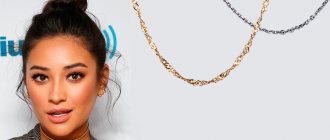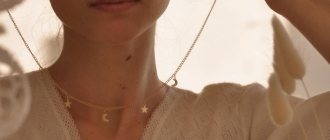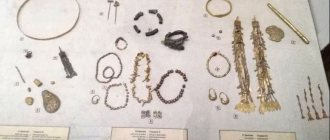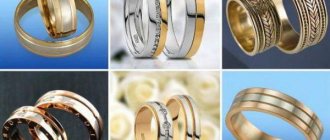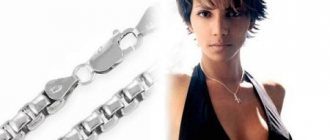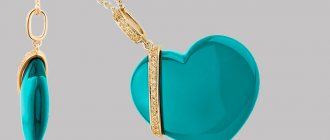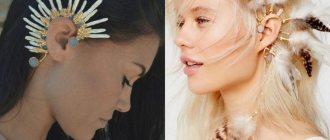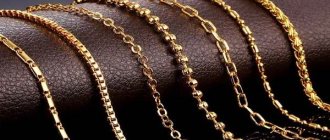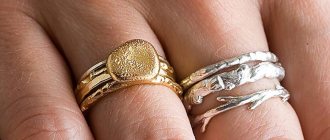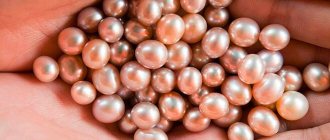Each of us in our lives is faced with the purchase of such jewelry as a chain. And first of all, we pay attention to the beauty and aesthetics of the product, but it is also important to pay attention to the clasp. The reliability of fixing the chain depends on its quality and type. In addition, it must be combined with the main part of the product. This functional element should not cause you discomfort while wearing it.
In this article we will look at the types of fasteners and give some simple tips on choosing a chain lock.
Spring clasp
The most common type of lock is the spring clasp. It is a small ring and fits perfectly with delicate jewelry. However, such an element has a number of disadvantages. First of all, it is difficult to secure it yourself. The internal mechanism, represented by a spring, often fails and replacing it is problematic. Moreover, you can lose the product unnoticed.
Karabinchik
The second no less popular clasp is called a lobster clasp. Its design is more reliable and simpler than the previous one. It is quite easy to fasten a product with such a fastener yourself by opening the spring latch. This eliminates unexpected loss of the chain. In case of breakdown, the mechanism is easy to repair.
Reference! Snap hooks are not suitable for thin and airy chain weaves due to their massiveness. Therefore, you will find such a fastener only on large products.
There are two types of fasteners: drop and rectangle. In the first case it is called a crab or lobster, in the second - a parrot.
Crutch
Simple, but at the same time strong and reliable. It is a small stick-pin that fits into the ring on the opposite side of the chain. With this closure, the product will definitely not open on its own and will slip out. Externally, the decoration with a pin clasp looks stylish and elegant.
Eight
In terms of its design, it is one of the simplest locks and at the same time extremely reliable.
Made in the form of a thin wire bent in the shape of a figure eight. The chain itself is threaded into one end, and the lock ring into the other. If your product is made of thin material, the clasp can easily unfasten and fall. Because of this, it is used only for jewelry.
Screw lock
Ideal for a necklace or necklace. The components of the structure on both sides of the chain are connected with a screw. A significant drawback is that the thread is extremely thin and the service life is short, especially if it is closed frequently.
Box
This fastener is considered the most reliable of all and is installed on expensive products. The cost of these chains is significantly higher, as the weight increases.
Using this lock you can connect large parts of the chain. The castle got its name because of its design. A part in the form of a box is attached to one end, and on the other there is a hook that fits into the box and is secured with notches.
There are several varieties and they all differ in the shape of the hook. For reliability, a clasp with a double-sided lock has been developed.
Chain lock
This is a type of box, only simpler. It can often be found in thin chains. One part is shaped like a tube and a hook is inserted into it.
Butterfly
This clasp is also one of the most reliable. It can be found less often in chains, mainly in bracelets. The main goal is to protect the product from accidental opening. The mechanisms are installed in such a way that this is practically impossible. They are shaped like butterfly wings and open in a similar way, hence the name. When buttoned, the lock is practically invisible.
Carbine
Carabiner lock
This is the most popular mechanism in the jewelry world. It is a loop, one side of which has a moving bracket. Opening such a lock on a bracelet is quite simple. It is enough to press the spring-loaded valve .
This design prevents the connecting ring from falling out
Experts recommend being careful with the retainer. Sharp jerks can easily deform the loop. In some cases, if you are not careful, you can break the clasp .
Eight
The lock is very simple in design. But at the same time it is not reliable enough. This is a thin wire bent in the shape of a figure eight. The product itself is threaded to one end, and a ring for fastening to the other. If the wire is not tight enough, the decoration can easily slip out of such a fastening.
Due to its shortcomings and uncomplicated appearance, it is used for inexpensive jewelry. Craftsmen do not undertake to repair such a lock, since it would be easier and more reliable to replace it with a new one.
Shringelny
This mechanism is a hollow ring containing a spring lock. Such fasteners are mass-produced exclusively in large factories. That is why it is often found on costume jewelry.
Spring clasp
The mechanism is lightweight, durable and small in size. Often a spring lock is used for thin chain bracelets .
The only drawback of such a lock is that the spring weakens or breaks over time. Most often this occurs as a result of regular wear. Due to everyday stress, the fasteners cannot withstand and break.
Learning to understand fasteners: main selection criteria
It is the clasp that bears the greatest functional load when wearing gold chains/bracelets. By complementing the product with pendants and pendants, we make them even heavier. If the mechanism is strong, then the lock is not in danger of losing its shape, but if not, it can easily become deformed, or even burst.
To prevent this from happening, the lock must be:
- Tight, and its parts are flexible (move/bend smoothly without jamming);
- Smooth, without sharp corners/jags;
- Easy to open.
Box-shaped
Craftsmen like to use such a fastener for products where, according to the plan, the fastener should not stand out from the overall composition
Box locks look like two elements: a clasp is inserted into a square piece, which has small protrusions at the tip.
The box mechanism is not often used in the jewelry industry. The fact is that the process of making the retainer is quite labor-intensive . But, despite this, the lock always looks beautiful on the accessory , as it fully corresponds to the intended design.
LiveInternetLiveInternet
Bracelets, beads, necklaces, pendants - the assembly of these types of jewelry, in most cases, is completed by installing a clasp. Beginning craftswomen often have a question about which clasp to choose when creating a particular piece of jewelry. After all, there are quite a few types of fasteners. This article is about clasps/clasps for jewelry. It provides a classification of clasps, describes in what cases and how they are used, and provides examples of photographs of jewelry with different clasps.
Clasps/clasps are a type of jewelry fittings used to fasten bracelets, beads, necklaces, and pendants. The size of the fasteners ranges from very tiny (only 5-6 mm wide) to very large (more than 4 cm). Most clasps have permanent loops; to attach the clasp to the decoration, you may need connecting rings and end caps (photo 1). Some clasps have a detachable loop, so the clasp can be directly attached to the end or chain on which the jewelry is assembled (photo 2). You can also do without connecting rings by using end switches with detachable loops (photo 3) or end switches with brackets (photo 4). In addition, there are adhesive end fasteners that are directly attached to the decoration (photo 5).
All fasteners can be divided into two groups: fasteners for single-row and multi-row jewelry (such fasteners have 2 or more loops/holes). Fasteners of the first group are more common and universal, since in almost all cases a multi-row fastener can be replaced with a single-row one using special adapters or multi-row ends (you can read about ways to complete multi-row decorations here).
Examples of single thread fasteners:
Examples of multi-thread fasteners:
Let us now consider what types of fasteners there are, depending on the principle of their operation:
1. Carabiners are perhaps the most popular type of fastener. They are also sometimes called crabs, lobsters, etc. Fasteners of this type have a movable part, which, when pressed on a special tongue (protrusion) on the carabiner, deflects inward, making it possible to hook the carabiner to the mate. The mating part can be an end loop, a connecting ring, an extension chain, or even a decorative element. Some carabiners have a rotating loop, which makes the jewelry less likely to twist when fastening. The photo below shows regular carabiners of different shapes and a carabiner with a rotating ring:
In addition to standard carabiners, there are carabiners that open outward (beak/claw clasp), as well as carabiners without a protrusion, which open by directly pressing the movable element (they can be either a regular shape or, for example, oval):
Carabiners are most often used in neck jewelry. You can also install carabiners on bracelets, but you may need someone's help when fastening the bracelet. The most convenient for bracelets, in our opinion, are carabiners with a rotating base.
Lobster clasps are usually made with one loop, but they can also be used for multi-row jewelry, as mentioned above.
One of the undoubted advantages of carabiners compared to many other types of fasteners is that carabiners can be installed together with an extension chain. Thanks to this technique, the length of the decoration can be easily changed within a few centimeters. This can be very useful for bracelets and necklaces created for sale.
Examples of finished jewelry with lobster clasps are presented below:
2. Rings - this type of fastener is most often found on purchased chains; they are used in the same way as carbines; they can also be installed with an extension chain. A ring fastener (spring lock) is a bent tube with a movable element between its ends. When pressed on a special tongue, the movable element is retracted inside the fastener, thereby opening it. If the tongue is released, the movable element will return to its place and the clasp will be closed. For high-quality ring clasps, when closed, the tip of the moving element must be inside the tube, and not just touching it - this way the jewelry will be fastened as securely as possible.
Below are photographs of two main designs of ring clasps and examples of finished jewelry with this type of clasp:
3. Toggles are fasteners consisting of two parts: a T-shaped stick and a mating part that has a hole several millimeters smaller than the length of the stick. At first glance, it may seem that the toggle is not a very reliable clasp. But that's not true. To fasten/unfasten the toggle, you need to turn the T-shaped element along the decoration and pass it through the hole of the mating part. The toggle will not be able to open until the wand is rotated accordingly. In jewelry, especially heavy ones, the togla stick is always perpendicular to the threads, and it is unlikely that it will turn without your help.
Toggles can have a wide variety of shapes:
Most often there are toggles with one thread. But there are also toggles with several loops/holes, designed to create multi-row decorations without the use of adapters:
Toggles are well suited for both neck decorations and bracelets (they are quite convenient to fasten/unfasten on the hand). Some toggles, thanks to their unusual design, can become the central element of decoration. If the toggle is installed on jewelry with large beads, be sure to make sure that the end of the jewelry with the toggle stick turned will go into the mating part of the clasp. If it turns out that the process of fastening/unfastening the clasp is difficult, it is better to add smaller beads or several connecting rings/chain before installing the clasp.
In our opinion, toggles have only one drawback - they cannot be installed on jewelry with adjustable length. More precisely, you can lengthen the decoration by installing, for example, a T-shaped element on one side, and on the other, several matching parts one after another or several large rings that fit the T-shaped element in size. But this method is suitable either for very small toggles or for large, massive necklaces. Otherwise, the decoration will look overloaded.
4. Hooks are another popular type of clasp, most often used for neck jewelry. Well suited for heavy jewelry, the weight of which will securely hold the jewelry fastened. Like a toggle, a hook can not only serve as a clasp, but also become the central element of a decoration.
Hook fasteners can be divided into three main types:
4.1) Hook & eye fasteners are two-piece fasteners consisting of a hook and a loop-shaped mate. Sometimes there are hooks of this subspecies without a mate; in this case, they are fastened with a connecting ring or a decorative element. There are wide hook-and-eye fasteners with a full-length eyelet designed for use with ribbons or flat leather cords.
Hooks of this type are easy to fasten/unfasten, and in most cases can be used with an extension chain. The shape of such hooks can be very diverse. Most often they have one loop on each side for attaching to the decoration, but they can be multi-row or glued:
4.2) S-hooks , as the name suggests, are double-sided open hooks in the shape of the English letter S (sometimes Z). Can be supplied complete with or without connecting rings. Like the previous hooks, these clasps are easy to use and can be installed on jewelry with adjustable lengths.
4.3) “Hook in a box” fasteners (fishhook) are two-component fasteners in which the hook first hooks into a loop on the mate, and then also hides in the mate, like in a box. To unfasten such a fastener, you need to lightly press on the protruding side parts of the hook and pull it out of the box, and then remove it like a regular hook.
These fasteners look very elegant, reliable, and easy to use. There are one or more threads. The disadvantage is that the length of jewelry with such a clasp is fixed; they cannot be used with extension chains.
Below are examples of finished jewelry with hook clasps:
5. Magnetic fasteners consist of two elements that are magnetic to each other. Most often they come in the shape of a ball/barrel/cylinder with loops for attaching to jewelry. Magnetic adhesive end clasps are also available. Sometimes, for greater reliability, magnetic fasteners are made with an additional latch: to unfasten the fastener, you must first rotate its elements relative to each other so that the latch pin falls into the desired groove, and then disconnect the magnets.
Magnetic clasps are used for both bracelets and necklaces. They look very neat and are easy to unfasten - well suited for jewelry made for the elderly or people with impaired fine motor skills or vision. It is not recommended to use magnetic clasps for heavy jewelry, as the weight of the jewelry may cause the clasp to unfasten spontaneously. Also, magnetic clasps are not suitable for creating jewelry with adjustable lengths.
Here are examples of jewelry with magnetic clasps:
Sometimes magnets are inserted into slider fasteners as additional fixation. We will talk about such fasteners a little later.
6. Twist fasteners are similar in appearance to magnetic ones, but they close by screwing one part of the fastener, with an external thread, onto another part of the fastener, with an internal thread. Most often, such fasteners come in the shape of a ball, cylinder or barrel. Most clasps of this type have loops that rotate freely in the clasp - this is necessary so that the decoration does not twist when using the clasp. For some twist clasps, attachment to the jewelry occurs through holes at the ends of the clasp: the ends of the thread are inserted into such a clasp and tied with knots inside it. Sometimes twist fasteners are made not only from metal, but also from plastic or even stone.
Screw clasps are commonly used for neck jewelry. Initially they are designed for single-row decorations, but with adapters they can also be used for multi-row ones. These clasps are quite reliable and suitable for heavy jewelry. Cannot be used for jewelry with adjustable length.
Examples of jewelry with twist clasps are shown below:
7. Snap (folding) clasps are most often found on finished women's watches or bracelets, but they can also be installed on necklaces. The main element of the fastener is placed on the mating part of the fastener, folded like a book and snapped onto a special protrusion. The mating part can be a connecting ring or an included element with a loop. Such fasteners may have loops for attaching to jewelry or be adhesive. Can be used with a large extension chain. If the clasp snaps tightly, the decoration will be quite secure. Fastening is quite simple, but to unfasten the clasp, you will have to pick up its moving part, which can be quite difficult to do with a small clasp.
The photo below shows examples of such fasteners and decorations with them:
8. Button fasteners are also snap fasteners; they always consist of two parts: one is a ring with a spring inside, the second is a platform with a rounded pin onto which the first part of the fastener is put. To fasten the snap clasp, you need to place the ring on the pin and push on the ring - the clasp will snap into place. To open the clasp, you need to rest against the pin and pull the ring up. This is done quite simply, so the clasp can be used both for neck jewelry and bracelets. If the clasp is made with high quality, then the decoration with it will be quite reliable. Jewelry with a snap clasp can only have a fixed length.
These clasps may vary in color and size, but they all have roughly the same design:
9. Pedal box fasteners consist of two parts: a decorative hollow part with a slot opposite the loop to which the thread is attached, and an element bent like a book, which, when compressed, is inserted into the slot of the decorative part and held in it, resting its upper and lower parts against the edges of the slot . Usually there is a small pedal on the top of the inserted part. To unfasten the box clasp, you need to press on this pedal and pull one part of the clasp out of the other. Sometimes, for reliability, an additional loop is made on the decorative element, above the slit: if the mate suddenly jumps out of the “box,” it will catch on this loop and the decoration will not fall, since the clasp will remain fastened like a hook. These fasteners are similar in appearance to hook-in-a-box fasteners.
As can be seen in the photographs presented above, fasteners of this type can have either one or several loops on each side. Box clasps can vary significantly in design and size. They can be very decorative and look good in decorations. Some clasps have a platform for decoration with rhinestones or cabochons.
Box clasps can be used for both necklaces and bracelets because they are easy to fasten and unfasten without assistance. These clasps are quite secure, however, it is not recommended to use pedal clasps for very heavy jewelry. They are also not suitable for jewelry with adjustable lengths. Here are examples of jewelry with pedal clasps:
10. Slider fasteners (tubes) consist of two parts, inserted into one another. The clasp is held closed either by a small spring loop on the insertion part or by magnets at the end of the clasp. To unfasten the clasp, you need to pull its ends in different directions (perpendicular to the threads of the decoration).
Tube clasps most often have from 2 to 9 loops on each side, that is, they are intended for multi-row decorations. They can also be used for wide wicker, leather, textile and other decorations. Sometimes there are slider tubes with one large loop along the entire length of the fastener: they are well suited for ribbons and flat cords. The sliders are very reliable and easy to use. They can be installed on both necklaces and bracelets. When using sliders, it is not possible to change the length of the finished decoration.
Below are examples of finished decorations with slider tubes:
So, we looked at the main, most common types of fasteners. In addition to these fasteners, there are also highly specialized or rare types of fasteners, such as connector fasteners for a chain with balls (photo 1), hybrid toggle hooks (photo 2), clothespin fasteners (photo 3), lariat fasteners (photo 4), buckle fasteners for leather cords (photo 5) and some others.
When choosing a fastener, it is quite easy for novice craftswomen to get confused in such a variety. How to choose the “right” clasp for your jewelry? We recommend paying attention to the following points:
1) Size of jewelry: small clasps will look neat in miniature jewelry; large clasps are better suited for massive jewelry.
2) Weight of jewelry: for heavy jewelry, for example, from large stone or porcelain beads, it is better to select the most reliable fasteners, such as carabiners, sliders, toggles, and some types of hooks.
3) Number of rows in the decoration: for multi-row or wide decorations, you should choose clasps with several loops or use adapter connectors.
4) Type of decoration: almost all types of clasps are suitable for neck jewelry, but for bracelets it is better to use more reliable clasps that will not unfasten on their own when your hand rubs against clothes or other objects. In addition, for bracelets it is better to use clasps that you can unfasten or fasten yourself while putting on the bracelet. Despite such limitations, you can choose a suitable clasp for a bracelet in almost any type of clasp - the main thing is to take into account all other factors. In our opinion, the most convenient clasps for bracelets are toggles, sliders, strong magnetic clasps, carabiners (if you get the hang of fastening them yourself).
5) Ease of use: when assembling jewelry, you must take into account the fact who will wear this jewelry. For people with low vision and impaired fine motor skills (for example, older people), it is better to use large, easy-to-fasten/unfasten clasps. For small children, it is better, on the contrary, to use clasps that are difficult to unfasten on their own - this reduces the likelihood that the decoration will be lost.
6) Does the length of the jewelry need to be adjusted: if the jewelry is made for sale, it is better to install a clasp that allows you to change the length of the jewelry, for example, by using an extension chain. Such fasteners include: carabiners, rings, hooks, snap fasteners. If the jewelry is created for a specific person, you can make the jewelry of a fixed size and use any type of clasp. Note that all types of fasteners can be used for transformable jewelry that has variable length. Even if the clasp does not have the possibility of extension (it consists of two parts that can only close on each other), you can make a decoration with several such clasps. That is, the decoration will consist of several parts, each of which can be fastened either on its own or attached to another part of the decoration. In this way, you can make beads/necklaces that can change length, or a bracelet and necklace that can be worn as a set, or can be clasped together and worn as long beads, as shown in the photo below:
7) Decoration design: of course, when choosing a clasp, you should definitely take into account the design of the decoration. The clasp should not stand out from the overall style of the decoration or draw attention to itself (unless, of course, it is the central element of the decoration).
In some cases, you can do without a fastener. For example, when assembling jewelry using an elastic band, memory wire, or when creating long beads worn over the head or tied in a knot. On bracelets woven from cords, the clasp can be replaced with a slip knot or a button clasp. Wide textile or leather bracelets can be laced. Examples of jewelry created without the use of clasps are presented below:
And finally, let’s consider non-standard options for using fasteners. For example, carabiners are often used to decorate keychains, bracelets, bookmarks, and sometimes earrings with pendants: the carabiner pendant can be easily detached and replaced with another, which makes the jewelry/accessory more versatile. Toggles themselves are sometimes used as pendants, and this applies to both rings and toggle sticks. Below are examples of the use of fasteners “not for their intended purpose”:
This article was prepared by employees of the Stylish Thing store specifically for the site stilnaya.com. You may not post this article or parts of it on other websites, print it in books, magazines, etc. without obtaining written permission from us. However, if you want to save some information for personal use, we are not against it.
Without lock
Accessories without locks are a hit in the jewelry world. This product is very easy to put on and take off . But the main advantage of not having a lock is reliability. The owner of a stylish one-piece piece of jewelry can be sure that she will not lose it due to a broken clasp.
So, the lock is the key detail on the bracelet. It depends on him how the jewelry will be fixed on the hand. Therefore, when choosing a product, you should carefully examine the lock and test it in action.
28.10.20
High-quality chains and bracelets at Diamant.ua!
YUK men's bracelets/chains are distinguished by their elegant design and cutting craftsmanship. Our assortment includes a large selection of products for women and men with stone inserts on a carabiner lock and a buckle. These are models with flowers and geometric symbols, with multi-colored and plain inlays.
Want something original? Customize your accessory parameters - from cut to insert shape/color!
No decorations
Are you looking for a delicate wedding option with pearls and zirconium, or a bracelet with curly rings for every day? Choose what is closest to you. We provide safe delivery and quality guarantee!
Karabinchik
One of the most common types of fasteners. Its design is simple and reliable. It will not allow the connecting ring to fall out spontaneously. Often chains around the neck are very difficult to fasten on your own.
However, a product with a carabiner can be easily put on without the help of others. The clasp lever is easy to pick up and hold with your fingernail. Plus it's easy to repair.
The carabiner has different shapes: in the form of a drop or a rectangle. The first is called crab or lobster, and the second is called parrot. They do not differ in technical characteristics. The appearance of the carabiner depends on the design of the decoration.
The disadvantage of this type of fastening is its massiveness. It is not suitable for thin air weaves.
Karabinchik
One of the most common types of fasteners. Its design is simple and reliable. It will not allow the connecting ring to fall out spontaneously. Often chains around the neck are very difficult to fasten on your own.
However, a product with a carabiner can be easily put on without the help of others. The clasp lever is easy to pick up and hold with your fingernail. Plus it's easy to repair.
The carabiner has different shapes: in the form of a drop or a rectangle. The first is called crab or lobster, and the second is called parrot. They do not differ in technical characteristics. The appearance of the carabiner depends on the design of the decoration.
The disadvantage of this type of fastening is its massiveness. It is not suitable for thin air weaves.

